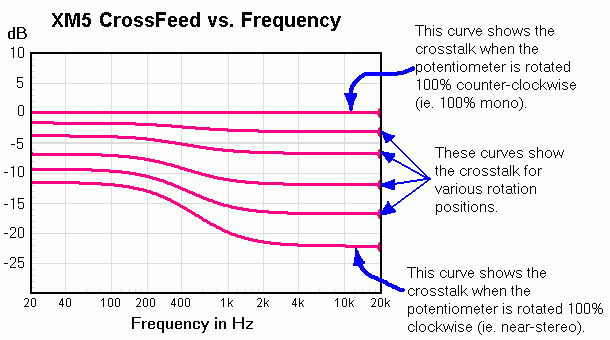 Links: Home Products: Headphone Amplifiers Cables Chips & SOIC Adapters Buy Now: XM6 Amplifier XM5 Amplifier XM4 Amplifier Cables Chips & SOIC Adapters Lithium Battery & Charger FAQs: XM6 Faq XM5 Faq XM4 Faq Payments & Shipping Shipping Costs Photo Gallery: XM6 Gallery XM5 Gallery XM4 Gallery Downloads Satisfaction Guarantee / Warranty Why Buy? Contact Us Copyright © 2015 Practical Devices Corporation. All rights reserved. |
Why would I need a Headphone Amplifier? If you own a reasonably-good quality set of headphones, you either need, or could probably benefit from, a headphone amplifier. Here's why: Quality headphones generally have an impedance of 64ohms or higher; some high-end 'phones have 600ohm impendence. Most portable audio devices, and a disappointingly-high number of home stereo amps, have output amps at their headphone jack which aren't capable of supplying enough voltage swing to drive the higher-ohmed headphones. The end result is your headphones are too quiet, and/or clipping occurs. What is the difference between the XM6, XM5, and XM4? The XM4 and the XM5 are the same physical dimensions; The XM6 is slightly smaller. All three use the same Lithium Charger. The major differences are shown:
What kind of headphones will the XM5 drive? The amplifier will drive any headphones with an impedance of anywhere between 24 and 600 ohms. This includes Sennheiser, AKG, Grado, Shure, Sony, Beyerdynamic, and many other headphone brands. For those of you who own headphones towards the higher end of that impedance range, you may need to enable the gain boost, for the extra +10dB of gain. Can I use the XM5 to drive small speakers? Usually, no. The XM5 was designed as a headphone amp, and will usually not do a good job of driving speakers, even small ones (most speakers have impedances of around eight ohms). What you are looking for is a power amplifier, not a headphone amplifier. Can I use the XM5 to amplify a Line-Level signal, such as from a CD player or VCR? Yes. What is the gain of the XM5? With the main volume knob at full volume, the overal gain for the XM5 is: Bass and Treble Boost buttons: How much boost? The bass and treble buttons on the front of the XM5 add the following boosts: Active Variable Crossfeed: What is it, and why do I want it? The XM5 is equipped with Active Variable Crossfeed. To use Crossfeed, the Crossfeed Enable switch (on the front of the XM5) must be in the IN position. Then, you can adjust the amount of crossfeed using the Crossfeed Adjuster potentiometer (the blue knob on the back of the XM5). Why You Want Crossfeed: Most music is mixed to be listened to on loudspeakers. The studio technicians mixing the recording assume there will be alot of crosstalk, since, with speakers, the listener's left ear clearly hears the right speaker's output, and vice versa. Thus, most music is mixed with a very wide stereo soundstage. With headphones, however, the left ear only hears the left channel, and the right ear only hears the right channel, with nearly zero crosstalk. This can, for many recordings, cause the soundstage to appear to be "in the center of your head". Further, some recordings (early Beatles' recordings are infamous for this) have each instrument and vocal track panned 100% to either left or right, which can quickly cause listener fatigue. The XM5's CrossFeed feature feeds some of the left channel into the right channel, and vice versa. In order to properly simulate the forward soundstage of loudspeakers, the amount of crossfeed needs to vary with frequency, which the XM5 does. Low frequencies (bass) bend around corners (including the corners of your head - bass from the left speaker will bend around your head and enter your right ear) much better than higher treble frequencies (treble is more directional); thus more crossfeed must occur in the lower bass frequencies. Further, the XM5 allows the user to adjust the overall level of crossfeed, from near-stereo to complete mono. This is adjusted using the crossfeed controller potentiometer on the back of the unit (don't forget to turn on the crossfeed with the CrossFeed Bypass Switch). The crossfeed vs frequency plot, shown for various crossfeed potentiometer positions, is shown below: |
||||||||||||||||||||||||||||||||||||||||||||||||||||||||||||||||||||||||||||||||||||||||||||||||||||||||

